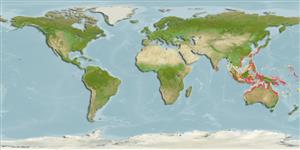Common names from other countries
Environment: milieu / climate zone / depth range / distribution range
экология
морской; солоноватоводный демерсальный; немигрирующий; пределы глубины 0 - 20 m (Ref. 86942). Tropical
Western Central Pacific: Philippines, Borneo, Singapore, Celebes, Papua New Guinea, New Georgia and Australia from the Northwest Shelf to Brisbane.
Size / Вес / Возраст
Maturity: Lm ? range ? - ? cm
Max length : 58.0 cm TL самец/пол неопределен; (Ref. 9790); common length : 30.0 cm TL самец/пол неопределен; (Ref. 9790); наибольший вес (опубликованные данные): 655.00 g (Ref. 3132)
колючие лучи спинного плавника (общее число) : 9; членистые (мягкие) лучи спинного плавника (общее число) : 11; колючие лучи анального плавника: 0; членистые (мягкие) лучи анального плавника: 11. Prominent pit present behind upper eye. Preopercular spines short, upper two subequal. Infraorbital ridge usually smooth over eye. Suborbital ridge bearing 1 spine below rear of eye. Dorsal fin IX or I,VIII. Dermal papillae (usually 6-9 in adults) on upper surface of eye, longest branched and reaching well above supraorbital ridge. Short dark streaks usually crossing rays in dorsal and caudal fins.
Inhabits shallow rocky coastal areas frequently associated with seaweed beds and mangroves, most commonly at depths of less than 5 m (Ref. 9790). Also found on sand bottoms (Ref. 3132).
Life cycle and mating behavior
Maturities | размножение | Spawnings | Egg(s) | Fecundities | личинки
Allen, G.R. and R. Swainston, 1988. The marine fishes of north-western Australia: a field guide for anglers and divers. Western Australian Museum, Perth. 201 p. (Ref. 3132)
Статус Красного Списка МСОП (Ref. 130435)
CITES (Ref. 128078)
Not Evaluated
Угроза для людей
Harmless
Использование человеком
рыболовство: рыболовство как средство для существования
дополнительная информация
инструменты
Специальные отчеты
Скачать в формате XML
ресурсы в Интернет
Estimates based on models
Preferred temperature (Ref.
115969): 24.7 - 29.3, mean 28.6 (based on 2366 cells).
Phylogenetic diversity index (Ref.
82804): PD
50 = 0.5625 [Uniqueness, from 0.5 = low to 2.0 = high].
Bayesian length-weight: a=0.00776 (0.00440 - 0.01371), b=3.05 (2.88 - 3.22), in cm Total Length, based on LWR estimates for this species & (Sub)family-body (Ref.
93245).
Trophic level (Ref.
69278): 4.0 ±0.7 se; based on size and trophs of closest relatives
устойчивость к внешним воздействиям (Ref.
120179): средний (среднего размера), минимальное время удвоения популяции 1.4-4.4 года (Preliminary K or Fecundity.).
Fishing Vulnerability (Ref.
59153): Moderate vulnerability (43 of 100).
